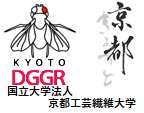†Kyoto piggyTrap Collection
Gene trap collection using a piggyBac-based transposon, with a GFP but without white or yellow.
Original site of piggyTrap is here *1
†Outline (by H. Matsubayashi)
Fusion proteins with fluorescence protein, such as GFP, have been widely used for assessing localization and function of target proteins. In Drosophila, random transposition of transposons containing an artificial GFP coding exon had been introduced as a method for making strains expressing GFP fusion proteins, and this strategy was known as protein trapping (Morin et al., 2001). If the transposon inserts into the intron of the coding sequence with correct orientation and frame, fusion protein with GFP is expected to be expressed. Since the trapped genes are expressed as a GFP fusion protein from its native promoter, its correct expression pattern and sub-cellular localization are easily viewed under a fluorescence microscope in living organisms. The original protein trap construct was created using the P-element as a transposon. However, P-elements are known to have an insertion preference into the 5' region of genes and hot spots for insertion. Furthermore, although previous extensive screens for protein trapping produced many strains (>9,053), true protein trap events were rare (Aleksic et al., 2009).
We (H. Matsubayashi & M.-T. Yamamoto) developed a new gene trap transposon based on piggyBac, named piggyTrap. piggyBac is known to have different and less hot spots as compared with P-elements, and preferential insertion into an intron. These features are preferable to the protein trap methodology. A piggyTrap transposon contains only an artificial GFP exon with minimum splicing signals and own translational start. This artificial exon is sandwiched between minimum terminal sequences from piggyBac, which is essential for its transposition. Total length is only 962 bp and has no stop codon in a frame compatible with the GFP coding frame throughout the transposon. This simple transposon was shown to be highly effective for gene trap ability. Almost all fly strains with fluorescence contain the piggyTrap transposon within the known or putative genes. About 60% of the strains contain the transposon within the intron of the coding region, thus expected to be a protein trap event. The rest contains the transposon into 5'UTR region, thus expected to be a promoter trap event. We have made more than 100 strains with this piggyTrap transposon, and some information of these strains will be described in this Page. All strains presented here are available from Drosophila Genetic Resource Center (Kyoto, Japan), and we believe that these strains must become valuable resources in many research areas.
†Structure of the piggyTrap transposon, PBac{EGFP-IV}
CCCTAGAAAGATAATCATATTGCGACGTACGTTAAAGATAATCATGCGTAAAATTGACGC
ATGTGTTTTATCGGTCTGTATATCGAGGTTTATTTATCTGCAGCTAATTTTTTCTTCCTT
ACAGATAATCAAA ATGGTGAGCAAGGGCGAGGAGCTGTTCACCGGGGTGGTGCCCATCCT
GGTCGAGCTGGACGGCGACGTAAACGGCCACAAGTTCAGCGTGTCCGGCGAGGGCGAGGG
CGATGCCACCTACGGCAAGCTGACCCTGAAGTTCATCTGCACCACCGGCAAGCTGCCCGT
GCCCTGGCCCACCCTCGTGACCACCCTGACCTACGGCGTGCAGTGCTTCAGCCGCTACCC
CGACCACATGAAGCAGCACGACTTCTTCAAGTCCGCCATGCCCGAAGGCTACGTCCAGGA
GCGCACCATCTTCTTCAAGGACGACGGCAACTACAAGACCCGCGCCGAGGTGAAGTTCGA
GGGCGACACCCTGGTGAACCGCATCGAGCTGAAGGGCATCGACTTCAAGGAGGACGGCAA
CATCCTGGGGCACAAGCTGGAGTACAACTACAACAGCCACAACGTCTATATCATGGCCGA
CAAGCAGAAGAACGGCATCAAGGTGAACTTCAAGATCCGCCACAACATCGAGGACGGCAG
CGTGCAGCTCGCCGACCACTACCAGCAGAACACCCCCATCGGCGACGGCCCCGTGCTGCT
GCCCGACAACCACTACCTGAGCACCCAGTCCGCCCTGAGCAAAGACCCCAACGAGAAGCG
CGATCACATGGTCCTGCTGGAGTTCGTGACCGCCGCCGGGATCACTCTCGGCATGGACGA
GCTGTACAAGGTAAGTACTC GAGATGTCCTAAATGCACAGCGACGGATTCGCGCTATTCA
GAAAGAGAGAGCAATATTTCAAGAATGCATGCGTCAATTTTACGCAGACTATCTTTCTAG
GG
†References
- Morin, X., Daneman, R., Zavortink, M., & Chia, W. (2001). A protein trap strategy to detect GFP-tagged proteins expressed from their endogenous loci in Drosophila. Proceedings of the National Academy of Sciences, 98(26), 15050-15055. doi: 10.1073/pnas.261408198
- Aleksic, J., Lazic, R., Müller, I., Russell, S. R., & Adryan, B. (2009). Biases in Drosophila melanogaster protein trap screens. BMC genomics, 10(1), 249. doi:10.1186/1471-2164-10-249
†Protocols
>>> Go to the original strain source site *2
†Stocks
To obtain Kyoto piggyTrap Collection, choose desired stocks from the stock list link below. Or, click gene symbol.
| All Stock List | >>> Click to open |
|---|
| Starter transposon strain | w*; P{w+mC=PBac{EGFP-IV}KM0007}KM0007}f1m1 |
|---|---|
| Transposase strain | w1118/Dp(1;Y)y+; P{w+mC=Hsp83-PBac-ORF}2 P{w+mC=Hsp83-PBac-ORF}5 |
| Chromosome Arm | Gene Symbol |
| X | cib |
| spoon | |
| CG3011 | |
| regucalcin | |
| CG2556 | |
| Smr | |
| Gmap | |
| Dsp1 | |
| nonA | |
| CG43658 | |
| CG6398 | |
| 2L | kis |
| GlyP | |
| aop | |
| Syt1 | |
| vkg | |
| Bsg | |
| Gγ30A | |
| Aldh | |
| CG33129 | |
| bun | |
| brat | |
| Df31 | |
| Acon | |
| RpL5 | |
| 2R | CG30497 |
| Cam | |
| sin3A | |
| shot | |
| CG14478 | |
| sm | |
| Sdc | |
| bl | |
| 3L | eIF5B |
| Hsp83 | |
| shep | |
| Sh3β | |
| Ank2 | |
| BI-1 | |
| rhea | |
| A2bp1 | |
| tna | |
| CG6084 | |
| CG10960 | |
| Adk1 | |
| endos | |
| ζCOP | |
| nudC | |
| Cat | |
| Indy | |
| Papss | |
| Pka-R1 | |
| skd | |
| mub | |
| 3LHet | Ucrh |
| 3R | heph |
| Map205 | |
| CG12163 | |
| CG1943 | |
| Unc-115a or Unc-115b | |
| bel | |
| CG9821 | |
| Kap-α3 | |
| Tm1 | |
| CG10311 | |
| Fas1 | |
| E2f | |
| RpS20 | |
| SKIP | |
| dan | |
| woc | |
| Ald | |
| Vha100-1 | |
| Ef1γ | |
| Cnx99A | |
| cpo | |
| aralar1 | |
| tmod | |
| 4 | eIF4G |
| Caps |


